
IP Static Routing
Module Objective: Configure IPv4 and IPv6 static routes.
| Topic Title | Topic Objective |
|---|---|
| Static Routes | Describe the command syntax for static routes. |
| Configure IP Static Routes | Configure IPv4 and IPv6 static routes. |
| Configure IP Default Static Routes | Configure IPv4 and IPv6 default static routes. |
| Configure Floating Static Routes | Configure a floating static route to provide a backup connection. |
| Configure Static Host Routes | Configure IPv4 and IPv6 static host routes that direct traffic to a specific host. |
15.1 Static Routes
Types of Static Routes
Static routes are commonly implemented on a network. This is true even when there is a dynamic routing protocol configured. Static routes can be configured for IPv4 and IPv6. Both protocols support the following types of static routes:
- Standard static route
- Default static route
- Floating static route
- Summary static route
Static routes are configured using the ip route and ipv6 route global configuration commands.
Next-Hop Options
When configuring a static route, the next hop can be identified by an IP address, exit interface, or both. How the destination is specified creates one of the three following types of static route:
- Next-hop route – Only the next-hop IP address is specified
- Directly connected static route – Only the router exit interface is specified
- Fully specified static route – The next-hop IP address and exit interface are specified
IPv4 Static Route Command
IPv4 static routes are configured using the following global configuration command: Router(config)# ip route network-address subnet-mask { ip-address | exit-intf [ip-address]} [distance] Note: Either the ip-address, exit-intf, or the ip-address and exit-intf parameters must be configured.
IPv6 Static Route Command
IPv6 static routes are configured using the following global configuration command: Router(config)# ipv6 route ipv6-prefix/prefix-length {ipv6-address | exit-intf [ipv6-address]} [distance] Most of parameters are identical to the IPv4 version of the command.
Dual-Stack Topology
The figure shows a dual-stack network topology. Currently, no static routes are configured for either IPv4 or IPv6. 
IPv4 Starting Routing Tables
- Each router has entries only for directly connected networks and associated local addresses.
- R1 can ping R2, but cannot ping the R3 LAN

IPv6 Starting Routing Tables
- Each router has entries only for directly connected networks and associated local addresses.
- R1 can ping R2, but cannot ping the R3 LAN.
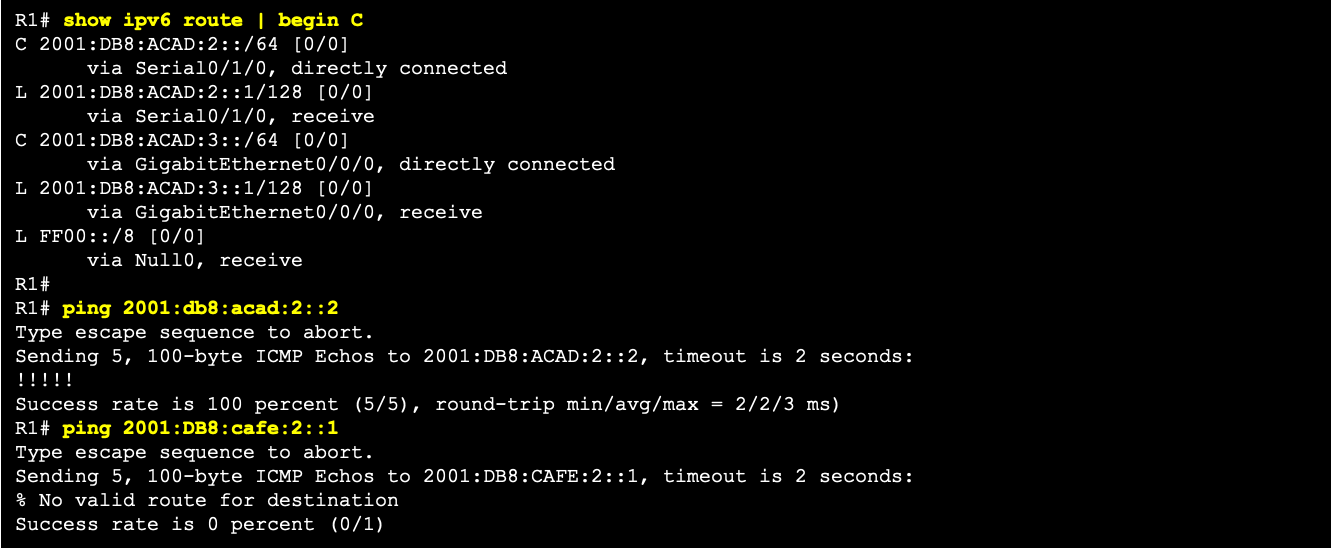
15.2 Configure IP Static Routes
IPv4 Next-Hop Static Route
In a next-hop static route, only the next-hop IP address is specified. The exit interface is derived from the next hop. For example, three next-hop IPv4 static routes are configured on R1 using the IP address of the next hop, R2.
R1(config)# ip route 172.16.1.0 255.255.255.0 172.16.2.2
R1(config)# ip route 192.168.1.0 255.255.255.0 172.16.2.2
R1(config)# ip route 192.168.2.0 255.255.255.0 172.16.2.2

IPv6 Next-Hop Static Route
The commands to configure R1 with the IPv6 static routes to the three remote networks are as follows: R1(config)# ipv6 unicast-routing R1(config)# ipv6 route 2001:db8:acad:1::/64 2001:db8:acad:2::2 R1(config)# ipv6 route 2001:db8:cafe:1::/64 2001:db8:acad:2::2 R1(config)# ipv6 route 2001:db8:cafe:2::/64 2001:db8:acad:2::2 The routing table for R1 now has routes to the three remote IPv6 networks. 
IPv4 Directly Connected Static Route
When configuring a static route, another option is to use the exit interface to specify the next-hop address. Three directly connected IPv4 static routes are configured on R1 using the exit interface. Note: Using a next-hop address is generally recommended. Directly connected static routes should only be used with point-to-point serial interfaces. R1(config)# ip route 172.16.1.0 255.255.255.0 s0/1/0
R1(config)# ip route 192.168.1.0 255.255.255.0 s0/1/0
R1(config)# ip route 192.168.2.0 255.255.255.0 s0/1/0
IPv6 Directly Connected Static Route
In the example, three directly connected IPv6 static routes are configured on R1 using the exit interface. Note: Using a next-hop address is generally recommended. Directly connected static routes should only be used with point-to-point serial interfaces. R1(config)# ipv6 route 2001:db8:acad:1::/64 s0/1/0 R1(config)# ipv6 route 2001:db8:cafe:1::/64 s0/1/0 R1(config)# ipv6 route 2001:db8:cafe:2::/64 s0/1/0 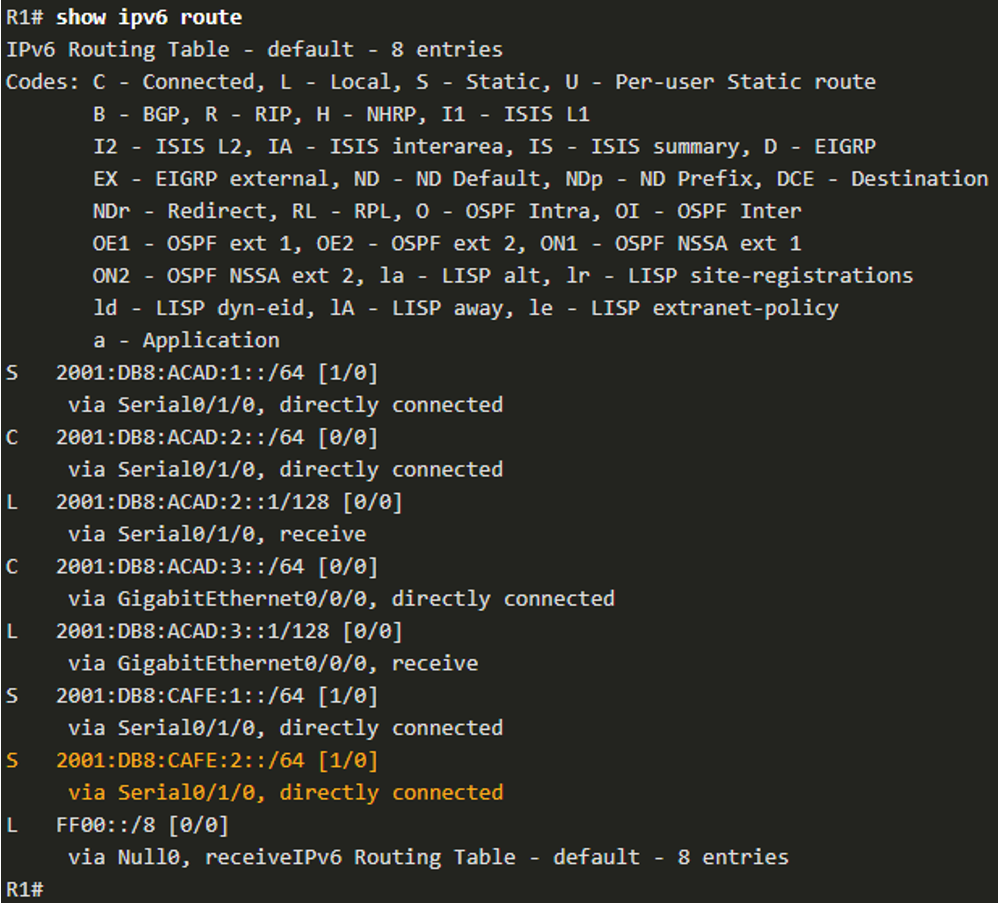
IPv4 Fully Specified Static Route
In a fully specified static route, both the exit interface and the next-hop IP address are specified. This form of static route is used when the exit interface is a multi-access interface and it is necessary to explicitly identify the next hop. The next hop must be directly connected to the specified exit interface. Using an exit interface is optional, however it is necessary to use a next-hop address. It is recommended that when the exit interface is an Ethernet network, that the static route includes a next-hop address. You can also use a fully specified static route that includes both the exit interface and the next-hop address. 

IPv6 Fully Specified Static Route
In a fully specified static route, both the exit interface and the next-hop IPV6 address are specified. There is a situation in IPv6 when a fully specified static route must be used. If the IPv6 static route uses an IPv6 link-local address as the next-hop address, use a fully specified static route. The figure shows an example of a fully specified IPv6 static route using an IPv6 link-local address as the next-hop address.  The reason a fully specified static route must be used is because IPv6 link-local addresses are not contained in the IPv6 routing table. Link-local addresses are only unique on a given link or network. The next-hop link-local address may be a valid address on multiple networks connected to the router. Therefore, it is necessary that the exit interface be included. The following example shows the IPv6 routing table entry for this route. Notice that both the next-hop link-local address and the exit interface are included.
The reason a fully specified static route must be used is because IPv6 link-local addresses are not contained in the IPv6 routing table. Link-local addresses are only unique on a given link or network. The next-hop link-local address may be a valid address on multiple networks connected to the router. Therefore, it is necessary that the exit interface be included. The following example shows the IPv6 routing table entry for this route. Notice that both the next-hop link-local address and the exit interface are included. 
Verify a Static Route
Along with show ip route, show ipv6 route, ping and traceroute, other useful commands to verify static routes include the following:
- show ip route static
- show ip route network
- show running-config | section ip route
Replace ip with ipv6 for the IPv6 versions of the command.
15.3 Configure IP Default Static Routes
Default Static Route
- A default route is a static route that matches all packets. A single default route represents any network that is not in the routing table.
- Routers commonly use default routes that are either configured locally or learned from another router. The default route is used as the Gateway of Last Resort.
- Default static routes are commonly used when connecting an edge router to a service provider network, or a stub router (a router with only one upstream neighbor router).
- The figure shows a typical default static route scenario.
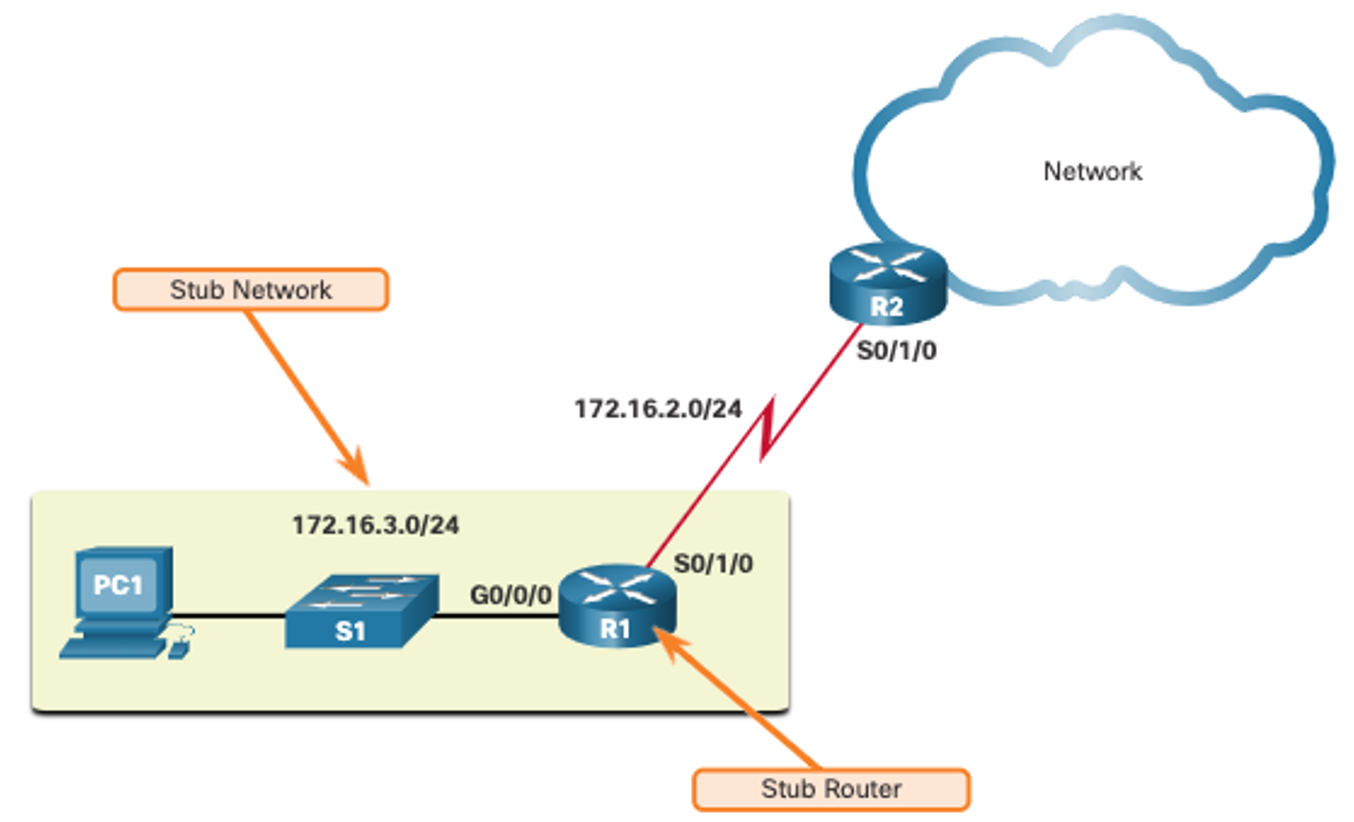 IPv4 Default Static Route: The command syntax for an IPv4 default static route is similar to any other IPv4 static route, except that the network address is 0.0.0.0 and the subnet mask is 0.0.0.0. The 0.0.0.0 0.0.0.0 in the route will match any network address. Note: An IPv4 default static route is commonly referred to as a quad-zero route. The basic command syntax for an IPv4 default static route is as follows:
IPv4 Default Static Route: The command syntax for an IPv4 default static route is similar to any other IPv4 static route, except that the network address is 0.0.0.0 and the subnet mask is 0.0.0.0. The 0.0.0.0 0.0.0.0 in the route will match any network address. Note: An IPv4 default static route is commonly referred to as a quad-zero route. The basic command syntax for an IPv4 default static route is as follows: Router(config)# ip route 0.0.0.0 0.0.0.0 {ip-address | exit-intf} IPv6 Default Static Route: The command syntax for an IPv6 default static route is similar to any other IPv6 static route, except that the ipv6-prefix/prefix-length is ::/0, which matches all routes. The basic command syntax for an IPv6 default static route is as follows: Router(config)# ipv6 route ::/0 {ipv6-address | exit-intf}
Configure a Default Static Route
The example shows an IPv4 default static route configured on R1. With the configuration shown in the example, any packets not matching more specific route entries are forwarded to R2 at 172.16.2.2. R1(config)# ip route 0.0.0.0 0.0.0.0 172.16.2.2 An IPv6 default static route is configured in similar fashion. With this configuration any packets not matching more specific IPv6 route entries are forwarded to R2 at 2001:db8:acad:2::2 R1(config)# ipv6 route ::/0 2001:db8:acad:2::2
Verify a Default Static Route
The show ip route static command output from R1 displays the contents of the static routes in the routing table. Note the asterisk (*) next to the route with code ‘S’. The asterisk indicates that this static route is a candidate default route, which is why it is selected as the Gateway of Last Resort. Notice that the static default route configuration uses the /0 mask for IPv4 default routes. Remember that the IPv4 subnet mask in a routing table determines how many bits must match between the destination IP address of the packet and the route in the routing table. A /0 mask indicates that none of the bits are required to match. As long as a more specific match does not exist, the default static route matches all packets.  This example shows the show ipv6 route static command output to display the contents of the routing table. Notice that the static default route configuration uses the ::/0 prefix for IPv6 default routes. Remember that the IPv6 prefix-length in a routing table determines how many bits must match between the destination IP address of the packet and the route in the routing table. A ::/0 prefix indicates that none of the bits are required to match. As long as a more specific match does not exist, the default static route matches all packets.
This example shows the show ipv6 route static command output to display the contents of the routing table. Notice that the static default route configuration uses the ::/0 prefix for IPv6 default routes. Remember that the IPv6 prefix-length in a routing table determines how many bits must match between the destination IP address of the packet and the route in the routing table. A ::/0 prefix indicates that none of the bits are required to match. As long as a more specific match does not exist, the default static route matches all packets. 
15.4 Configure Floating Static Routes
Floating Static Routes
- Another type of static route is a floating static route. Floating static routes are static routes that are used to provide a backup path to a primary static or dynamic route. The floating static route is only used when the primary route is not available.
- To accomplish this, the floating static route is configured with a higher administrative distance than the primary route. The administrative distance represents the trustworthiness of a route. If multiple paths to the destination exist, the router will choose the path with the lowest administrative distance.
- By default, static routes have an administrative distance of 1, making them preferable to routes learned from dynamic routing protocols.
- The administrative distance of a static route can be increased to make the route less desirable than that of another static route or a route learned through a dynamic routing protocol. In this way, the static route “floats” and is not used when the route with the better administrative distance is active.
Configure IPv4 and IPv6 Floating Static Routes
The commands to configure default and floating IP default routes are as follows: R1(config)# ip route 0.0.0.0 0.0.0.0 172.16.2.2 R1(config)# ip route 0.0.0.0 0.0.0.0 10.10.10.2 5 R1(config)# ipv6 route ::/0 2001:db8:acad:2::2 R1(config)# ipv6 route ::/0 2001:db8:feed:10::2 5 The show ip route and show ipv6 route output verifies that the default routes to R2 are installed in the routing table. Note that the IPv4 floating static route to R3 is not present in the routing table. 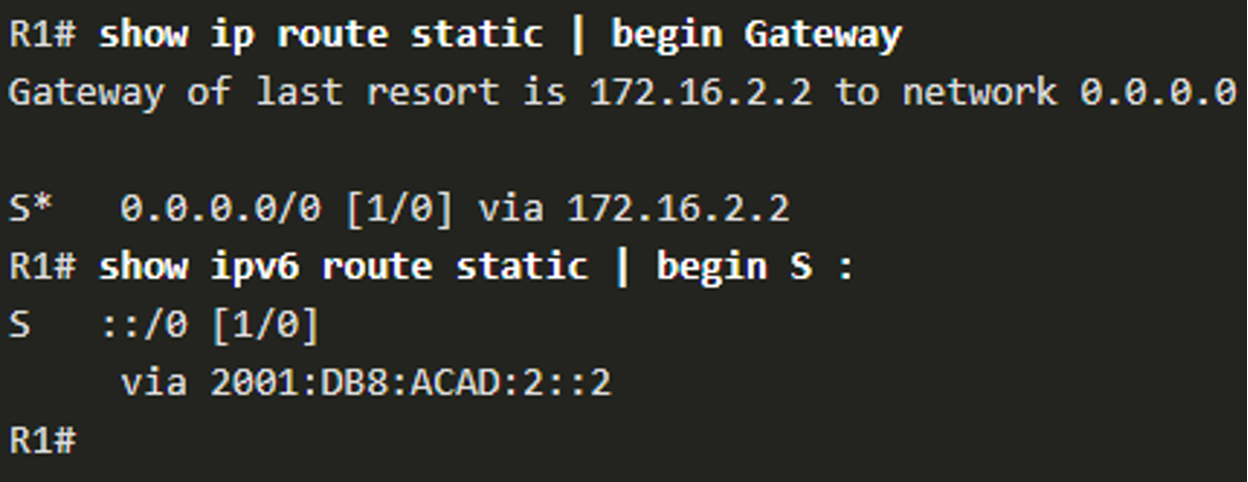
Test the Floating Static Routes
- What would happen if R2 failed? To simulate this, R2 shuts down both of its serial interfaces.
- R1 automatically generates syslog messages for the link going down.
- A look at R1’s routing table would show the secondary route being used.


15.5 Configure Static Host Routes
Host Routes
A host route is an IPv4 address with a 32-bit mask, or an IPv6 address with a 128-bit mask. The following shows the three ways a host route can be added to the routing table:
- Automatically installed when an IP address is configured on the router
- Configured as a static host route
- Host route automatically obtained through other methods (discussed in later courses)
Automatically Installed Host Routes
- Cisco IOS automatically installs a host route, also known as a local host route, when an interface address is configured on the router. A host route allows for a more efficient process for packets that are directed to the router itself, rather than for packet forwarding.
- This is in addition to the connected route, designated with a C in the routing table for the network address of the interface. The local routes are marked with L in the output of the routing table.
Static Host Routes
A host route can be a manually configured static route to direct traffic to a specific destination device, such as the server shown in the figure. The static route uses a destination IP address and a 255.255.255.255 (/32) mask for IPv4 host routes, and a /128 prefix length for IPv6 host routes. 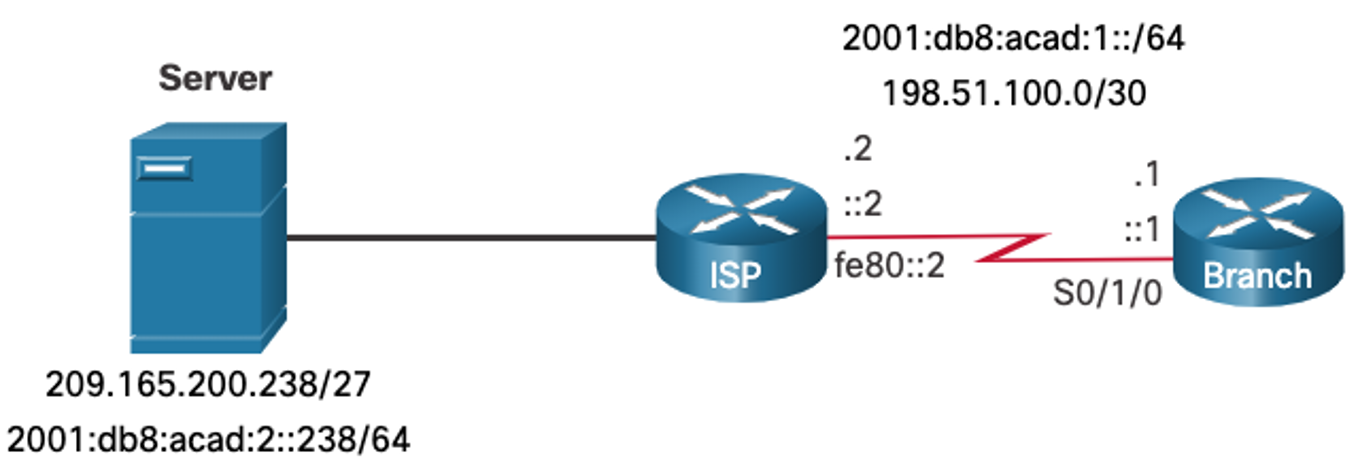
Configure Static Host Routes
The example shows the IPv4 and IPv6 static host route configuration on the Branch router to access the server. Branch(config)# ip route 209.165.200.238 255.255.255.255 198.51.100.2 Branch(config)# ipv6 route 2001:db8:acad:2::238/128 2001:db8:acad:1::2 Branch(config)# exit
Verify Static Host Routes
A review of both the IPv4 and IPv6 route tables verifies that the routes are active. 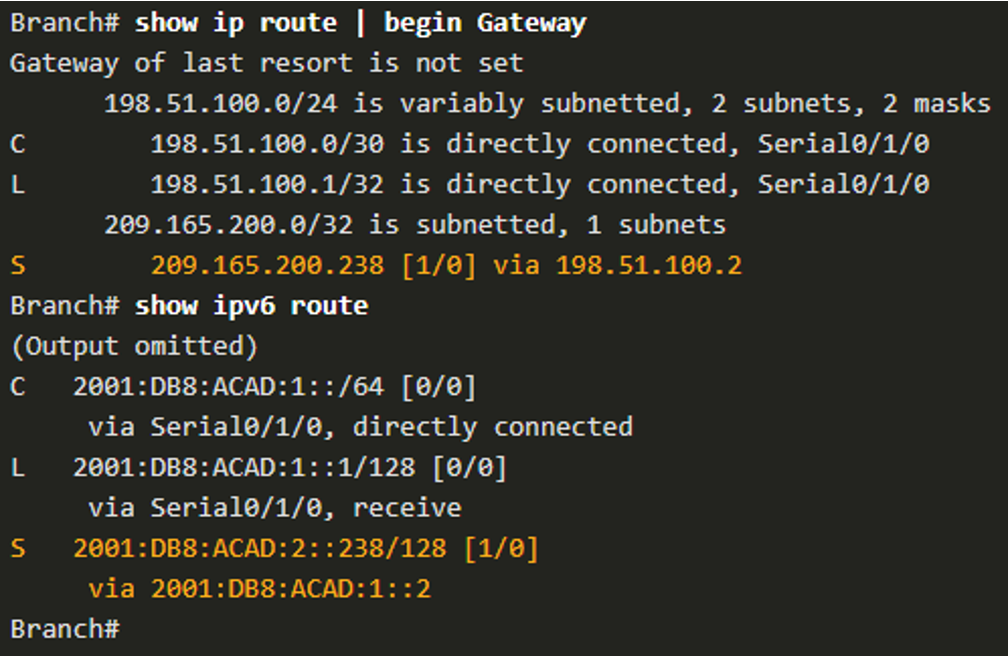
Configure IPv6 Static Host Route with Link-Local Next-Hop
For IPv6 static routes, the next-hop address can be the link-local address of the adjacent router. However, you must specify an interface type and an interface number when using a link-local address as the next hop, as shown in the example. First, the original IPv6 static host route is removed, then a fully specified route configured with the IPv6 address of the server and the IPv6 link-local address of the ISP router. 